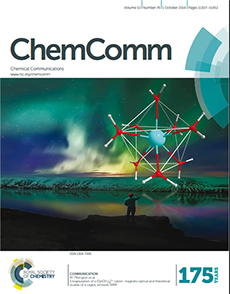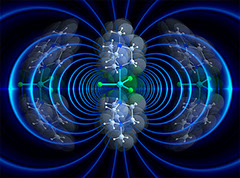


<
>
PHOTONIC HYBRIDS AND NANOMATERIALS GROUP
Aveiro-Portugal
university of aveiro
theoria poiesis praxis
physics department
ciceco
aveiro institute of materials


HOME > RESEARCH > RESEARCH LINES > SINGLE ION & SINGLE MOLECULE MAGNETS
SINGLE ION & SINGLE MOLECULE MAGNETS
Multifunctional Single-Molecule Magnets (SMMs) or Single-Ion Magnets (SIMs) are intriguing molecule-based materials presenting an association of the slow magnetic relaxation with optical properties, which can exist separately or act in synergy. Luminescence spectroscopy is a useful tool to enable the experimental determination of the electronic structure, resulting from the crystal field splitting and finely determine the energy gap between the ground and the first excited state, which may be considered as an Orbach barrier, which is often difficult to properly extract from the magnetic measurements.
PEOPLE
Luís D. Carlos
Rute A.S. Ferreira
RESEARCH HIGHLIGHTS
Recent advances in luminescent lanthanide based Single-Molecule Magnets, by Jérôme Long, Yannick Guari, Rute A.S. Ferreira, Luis D. Carlos and Joulia Larionova, Coord. Chem. Rev. 2018, 363, 57-70. https://doi.org/10.1016/j.ccr.2018.02.019
Luminescent lanthanide-based Single-Molecule Magnets (SMM) are multifunctional molecule-based materials that combine luminescence and magnetic properties in the same crystalline structure, which can exist separately or act in synergy. Here we present a short overview focalizing on recent advances in this family of SMM and give the outlook on the future researches in this domain.
A High-Temperature Molecular Ferroelectric Zn/Dy Complex Exhibiting Single-Ion-Magnet Behavior and Lanthanide Luminescence, by Jérôme Long, Jérôme Rouquette, Jean-Marc Thibaud, Rute A. S. Ferreira, Luís D. Carlos, Bruno Donnadieu, Veaceslav Vieru, Liviu F. Chibotaru, Leszek Konczewicz, Julien Haines, Yannick Guari, and Joulia Larionova, Angew. Chem. Int. Ed. 2015, 54, 2236–2240. http://dx.doi.org/10.1002/anie.201410523
Multifunctional molecular ferroelectrics are exciting materials synthesized using molecular chemistry concepts, which may combine a spontaneous electrical polarization, switched upon applying an electric field, with another physical property. A high-temperature ferroelectric material is presented that is based on a chiral Zn2+/Dy3+ complex exhibiting Dy3+ luminescence, optical activity, and magnetism. We investigate the correlations between the electric polarization and the crystal structure as well as between the low-temperature magnetic slow relaxation and the optical properties.
Encapsulation of a [Dy(OH2)8]3+ cation:magneto-optical and theoretical studies of a caged, emissive SMM, by M. Al Hareri, E. L. Gavey, J. Regier, Z. Ras Ali, L. D. Carlos, R. A. S. Ferreira, M. Pilkington, Chem. Commun., 2016, 52, 11335-11338. http://dx.doi.org/10.1039/C6CC03578G COVER HIGHLITHED.
The first supramolecular cage formed by three benzo-15-crown-5 macrocycles encapsulating a [Dy(OH2)8]3+ guest cation is reported, with the Dy(III) centre exhibiting local pseudo square antiprismatic D4d symmetry. The anisotropy barrier extracted from ac susceptibility studies, emission spectroscopy and ab initio calculations reveals that the second excited state Kramers doublet plays a key role in the magnetization dynamics due to the Ising character and near coparallel nature of the ground and first excited Kramers doublets.
Lanthanide salen-type complexes exhibiting single ion magnet and photoluminescent properties, by Min Ren, Zhong-Li Xu, Song-Song Bao, Ting-Ting Wang, Ze-Hua Zheng, Rute A. S. Ferreira, Li-Min Zheng, Luis D. Carlos. Dalton Trans., 2016, 45, 2974–2982. http://dx.doi.org/10.1039/C5DT03897A
Mononuclear lanthanide salen-type complexes are reported, which contain a [LnN4O4] core. The lanthanide centers are encapsulated by two 3-NO2-salen2- ligands in a meridional configuration. Magnetic studies reveal a spin parity effect. A field-induced magnetization relaxation is observed in compounds 3Dy·H2O, 5Er·1.5H2O and 6Yb which contain Kramer ions, while not in compounds 2Tb·0.5H2O·CH3OH and 4Ho·0.5H2O·CH3OH which contain non-Kramer ions. Compound 3Dy·H2O provides the first example of mononuclear lanthanide salen-type complexes that exhibit slow magnetization relaxation at zero dc field, characteristic of a SIM behavior. The spin reversal heights are obtained as 39.7 K for 3Dy·H2O, 8.7 K for 5Er·1.5H2O and 7.5 K for 6Yb. Photoluminescence studies reveal that ligand 3-NO2-salen2- is an excellent antenna chromophore for sensitizing Eu3+, Er3+ and Yb3+ ions in the region of 300–500 nm, while it is inefficient in sensitizing Tb3+ and Dy3+ ions.


MADE BY PHANTOM-G, AVEIRO, PORTUGAL

